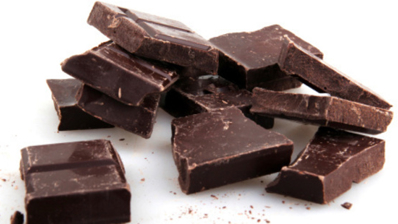We Know Why Chocolate Goes That Weird White Colour!
- Publish date
- Tuesday, 12 May 2015, 9:59AM

You know when you need to stress eat but you devastatingly discover your emergency chocolate stash has accumulated weird white stuff all over it and you have to decide, do I eat this? Just us?
OK, well this is a real problem in need of real solution, not just for chocolate aficionados but the entire chocolate industry. Now a group of German scientists say they've used X-rays to figure out the underlying process behind the "fat blooming" on chocolate to help reduce the whiteness. They published their findings in the latest issue of the journal Applied Materials and Interfaces.
First things first: that white stuff is made up of fats and it's edible (so no judgies if you see me feeding white-tinted chocolate into my face). Chocolate's ingredients don't always stay put and when liquid fats within chocolate migrate to the surface, they can crystalise and form a fat bloom.
The change in texture and appearance are not good ones, though. And the exact processes of these fat blooms haven't been examined in real-time, according to this group of researchers from Hamburg University of Technology, German research center DESY and Nestlé.
So they turned to a high-powered machine, the PETRA III, which captures high-brilliance X-rays, to watch what's going on within our favorite sweet.
First, scientists combined the main ingredients of what makes chocolate - cocoa, sugar, milk powder and cocoa butter - and ground up the mixture into a fine powder.
Then they added a little sunflower oil to wet the mixture. The oil took only seconds to move through the chocolate, and it went into even the tiniest pores.
Over a few hours, the oil that migrated through the chocolate had dissolved the cocoa butter into a liquid that then softened the chocolate as a whole, and increased the movement of fats to the surface.
The X-rays captured the action as it showed the pores and fat crystals at a very small scale, down to just a few nanometers.
"For the first time, we have been able to track in detail the dynamic mechanisms that lead to the creation of fat bloom," DESY scientist and study co-author Stephan Roth said in a statement. "The method used is known as small-angle X-ray scattering and is precisely adapted to real-time investigations of this kind, and to observing the structural changes caused by the moving lipids."
The American Chemistry Society, which publishes the journal Applied Materials and Interfaces, pointed to the study as a step to "avoiding the dreaded chocolate 'bloom.'"
Researchers suggested reducing the number of pores within chocolate so fats migrate more slowly, or lessening the amount of liquid fats by storing chocolate in cooler temperatures, around 18 degrees Celsius.
"At 5 degrees, basically, all cocoa butter is solid; and above about 36 degrees everything is liquid," said the main author Svenja Reinke of Hamburg University of Technology.
There's a tendency to take the whiteness as a sign of spoiled chocolate, given that the blooming also happens the longer chocolate is stored. And that's a problem for chocolate makers.
"Even though fat bloom does not actually constitute any deterioration in the quality of the product, the visual alteration associated with it can lead to a large number of consumer complaints," said study co-author and Nestlé scientist Stefan Palzer. "This is why fat bloom continues to be one of the most important quality defects in the confectionery industry."
It's also one of the most important quality defects in my candy drawer.
- Image: Thinkstock
Take your Radio, Podcasts and Music with you

